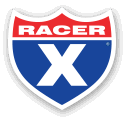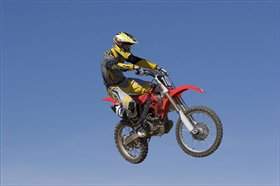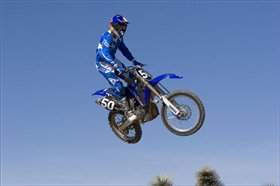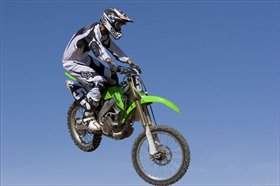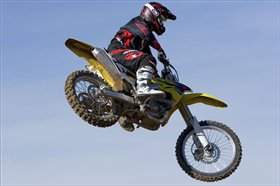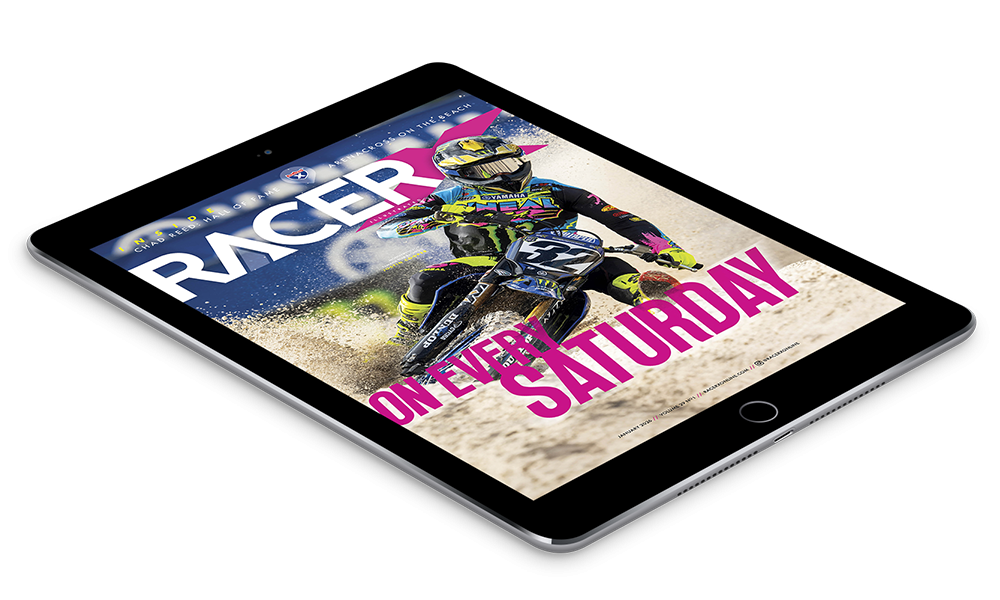Racer X Tested: 2007 250F Shootout
Tiddlers?
The 2007 250 four-stroke offerings from the major motocross manufacturers are all excellent. At the individual press rides, I walked away thinking that each bike could be the shootout winner. But the rubber definitely meets the road—or dirt, in this case—when we have all of the bikes at the same tracks on the same days and we can ride them back-to-back-to-back-to-back-to-back. They say good help is hard to find, but that hasn’t been the case for me this fall. In our 450 shootout, Ron Lechien put his duties at Maxima Racing Lubricants on hold and helped us shake down the newest big bikes. How do you top that? I mean, he’s the Dogger! Well, I called up Johnny O’Mara and asked if he would come help us out. Right before I started into my rehearsed spiel about why he should join us, he agreed. The O Show was in as our final Racer X test rider.
The 250F class of 2007
Here And There

It’s important to have the right kind of track when you are testing motocross bikes. If the track is too smooth, the riders can’t give any feedback about the handling. If the track is too hard and slick, then it is difficult to judge horsepower and braking power. We hit a couple of southern California’s best facilities, Competitive Edge Motocross Park and Cahuilla Creek Motocross Park, to really figure things out. Competitive Edge was left rough from a previous practice day, so it was choppy, rutted, and more hard-packed. Cahuilla Creek was plowed deep, so the track was completely different from the conditions on day one.
The System
Over the course of two days, all of us rode each bike as many times as necessary to determine their ranking. Points were awarded, five being the best and one being the worst. Points were tallied at the end to determine the winner. The riders’ thoughts and views are exactly as they were written.
The Word
Johnny O’Mara
1. Suzuki
2. Kawasaki
3. Honda
4. KTM
5. Yamaha
|
I was really impressed with the Kawasaki’s motor. It has a strong hit on the bottom and it revs farther than any of them. It is a good, solid motor. The suspension was also very good. It was predictable and stable. I didn’t have any problems with it at all. I was very comfortable on the Kawasaki right away. The bike is very roomy and easy to feel comfortable on. It did everything pretty well, but I think the Suzuki was just a little bit better in the corners and the small bumps.
The Honda has a decent motor, but it isn’t spectacular. It’s solid. I thought the suspension was good but not outstanding. It has a very firm feel to it, especially on the hard, choppy bumps. I had a tough time getting the front end to stick coming into choppy turns. The Honda is very comfortable. They have always had a very comfortable cockpit, and this bike has that same feel. It cornered well, but it wasn’t a standout like the Suzuki.
The KTM is a good bike. The motor is right in there, the suspension is decent, the brakes and clutch are good, and the feel is comfortable. It just didn’t do anything exceptionally well.
The Yamaha was disappointing to me. The motor felt a little slow and I got really bad headshake a few times in the faster sections of the track. The cornering was just average, and the feel of the bike was just okay. I really was expecting more from the Yamaha.
Victor Sheldon
|
2. Kawasaki
3. Honda
4. Suzuki
5. KTM
I liked the Yamaha best from the first time I rode all of them. The motor isn’t the fastest, but it is very usable and great all around. The suspension was the best to me. The forks are so stable and absorbed hard landings way better than any of the others. It is a very stable bike. It did want to push in the turns a little bit. I felt like I could go faster on this bike for sure.
The Kawasaki has amazing bottom and mid power. I thought the suspension could be more plush. It had a stiff feel to it, even when I opened the clickers up. I loved the way the Kawasaki felt, though. I was the most comfortable on this bike right away. It just feels like it fit me really well. It was great in the turns and very stable at speed. It was a very close second to the Yamaha.
The Honda is third, but it is a really good bike too. The motor is really fast and manageable. I thought the suspension was too stiff or harsh for the average rider. Maybe a guy that is pushing it super hard, like a top pro, would want it that stiff, but it was pretty firm-feeling for me. I felt like I sat up a little too high on this bike. The others feel like you sit down in it, and I like that better for me. I also had a hard time getting the bike to stick into turns because it is so stiff.
The Suzuki has a really good engine. The over-rev is great and the powerband is really long. The suspension was nice and soft, a lot like the Kawasaki. The front end seemed a little long to me. Maybe it was the fender or something; I’m not sure. Really, all the bikes are super-close.
The KTM had a really strong motor at low rpm. The bike feels really light, which I liked a lot, but I had some headshake with the front end. Also, the seat was so stiff it made it hard to sit down. You had to be standing when you hit bumps or it would hurt your butt. The brakes and clutch and controls are awesome. The finishing details are the best on this bike, for sure. It turns great, also, especially in the tighter stuff.
Randy Lawrence
|
1. Kawasaki
2. Yamaha
3. Suzuki
4. Honda
5. KTM
The Kawasaki motor is strong all the way through. It has a smooth roll-on power that’s easy to ride. It handles well on flat turns as well as ruts. I could lean leading into a rut in the chop and feel comfortable. It has a plush feel but handled bigger landings well. It is probably a little soft for the upper-level rider. It has good brakes but the front is a little soft. The Kawasaki is comfortable and easy to ride. It held ruts nicely, and I could continue to push corners harder and harder as I got more used to it.
The Yamaha has a strong motor with great power that is very smooth. It pulled each gear well and didn't flatten off. It revved well. It is a very easy motor to ride. It also handled great. It is very plush in the choppy bumps, and it didn't kick under braking or acceleration. The front end was stable and also good on big landings. The Yamaha has great brakes with a good positive feel. If you've ever liked the way a Yamaha felt, you will love this one. They did a great job keeping the “Yamaha feel” and giving you a great motor and suspension that's easy to ride. It also corners great. It’s light and easy to find ruts and stay in them without to much effort. It’s good on flat turns as well.
The Suzuki has a good, smooth power. It felt like it wanted a pipe. I was in between gears with standard gearing, but changing to a 50-tooth sprocket solved the problem. The suspension was stable and plush. It’s a little soft when you start to brake hard, but it was good in the chop under braking and acceleration. As I rode harder, it felt a little on the soft side. The brakes are good but just a little soft, and the bike is comfortable and easy to ride.
The Honda has a great motor. It’s strong from the bottom through the top. I could race this motor as it sits. It runs best at higher rpm. The suspension felt harsh, though. The track was super choppy and it was difficult to lean into corners in the chop. Once I was in the rut, it felt good. It definitely suits more aggressive riders. The brakes and controls were super, which is typical from Honda. The feel of the bike is awesome. It’s a very solid bike, and it felt narrow and easy to grip. It has a twitchy feel in the turns. It’s kind of harsh feeling and gives a lot of feedback to your hands. That made it hard to hang on to.
The KTM has an excellent motor with great power all the way through. It’s very easy to ride. The suspension is a little on the harsh side. There’s lots of feedback in the hands but no headshake. The rear was a little kicky on acceleration if you weren't in a straight line. I had trouble holding a line leaning into a turn in the braking bumps. It has excellent brakes, and the controls felt light and easy to use. It’s comfortable but a little tall in the rear. I could push harder as I got more used to it.
To me, all the bikes are great. I don't ride much or have time to get parts to and from aftermarket places, so I picked based on which bike was easy to ride and what I could do with stock settings.
Chad Pederson
|
1. Kawasaki
2. Yamaha
3. Suzuki
4. KTM
5. Honda
The Kawasaki was just the best overall package for me. The engine was the best out of the group. It had great bottom and a ton of over-rev. It handled well and never did anything that I didn’t like.
The Yamaha was a close second. The suspension is really good. The motor was slightly weaker than the Kawasaki, but it was still good. It’s a very solid bike—it just didn’t handle quite as well as the Kawasaki. It was a very close second, though.
The Suzuki was a big surprise for me. I didn’t care for last year’s bike, but the 2007 is really good. I had a problem with the bike knifing in faster turns. The steering was a little too quick for me. The motor was a little slower than the Kawasaki and Yamaha also. It is a great bike, though, and the new chassis and suspension are great.
The KTM was a little stiff-feeling. The shock had a very harsh feel to it, especially on the sharp, square-edged bumps. The motor was good off the bottom, but it was weak through the meat of the power. I was bummed with the engine because they are usually the strong point with KTM.
The Honda motor felt the weakest. It had no top end. If you let the rpm get too high it would hit the limiter and go nowhere. The suspension was way too stiff and had a harsh feeling on braking and acceleration bumps. The whole bike had a very stiff, firm feel to it.
Phil Lawrence
1. Honda
2. Yamaha
3. Suzuki
4. Kawasaki
5. KTM
The Honda motor worked the best for me. It is faster than last year’s bike and worked cleaner. I was the most comfortable on the Honda right away. I could just jump on it and ride it aggressively as soon as I got on the track. I felt the most confident on this bike. The handling is awesome. It’s stable and you can aim it right through bumps and chop and it doesn’t move around at all. The stability is incredible.
The Yamaha is an all-around great bike. It has a great motor and probably the best suspension. It didn’t feel like I could turn it as easily as the Honda, and that is the only reason it didn’t win. I had a harder time sticking inside ruts or turning inside of a line at the last minute. It wants a berm or a rut to turn on.
The Suzuki feels like a smaller bike. With a little work, it could be the best. I would raise the ride height and move the bars forward and up. I was really surprised with it, though. The motor is smooth and the suspension works really well. The bike has a great feel to it.
The Kawasaki handled really well. The suspension worked awesome without really changing any clickers or anything. The motor has a big flat spot in it that bugged me. It has a hit on the bottom, but then it went flat in the middle. It has a ton of over-rev, so the only way I could go fast was to rev the crap out of it. But it is a really comfortable bike and the chassis is great. I just had some problems making the power work for me.
I was really bummed with the KTM. The 450 engine was so good that I was looking forward to riding the 250F. It just lacked power. It had decent top end, but it wasn’t anything too impressive. The suspension needs some work too. There is a really harsh feel to the shock. I also had to go to 115 mm of sag just to keep the forks from diving when I came into turns. I really expected more from the motor.
David Pingree
|
1. Suzuki
2. Yamaha
3. Honda
4. Kawasaki
5. KTM
I liked all of the bikes. I think all of our test riders felt the same way. The differences between the bikes are very small, and most issues could be resolved easily. It made it very difficult to rank them, but I chose the Suzuki as the winner. The new chassis and suspension are incredible. The bike is stable at speed but turns better than any of the other bikes. The forks were so plush, they felt like they were valved specifically for me. I was really impressed with the suspension. The cockpit was super comfortable to me, but I know some of the bigger riders thought it was a little small. The motor feels a little slow at first because the power is so linear. There isn’t a big hit anywhere, and that characteristic makes it very easy to ride. I would love to ride one of these bikes with an exhaust and some motor work. The levers, brakes, and details were all quality on the Suzuki.
The Yamaha is a very close second. The motor was slightly stronger than the Suzuki, but I was less comfortable with the way it handled. The shock is taller than last year’s bike, and it made the back end move around more. The seat would hit me in the butt on big braking bumps, and even when I added sag to lower the ride height, I had trouble getting the bike to settle into a turn. The forks on the Yamaha are great. They absorbed hard landings better than any other bike, and they were plush on braking bumps as well. The new bars are an improvement and make the Yamaha much more comfortable to ride.
The Honda is a close third. I had to shift more on the CRF to keep the bike in the bulk of the power. If I let the rpm get too high it would hit the limiter and go nowhere. The suspension has a firm feel to it but the harder you ride it, the better it works. It seems suited better to a pro-level rider. The chassis is second to none. The Honda goes straight as an arrow through the roughest sections on the track, and turning is as easy as spotting your line and aiming for it. As usual, the brakes and finishing touches on the CRF are superb.
The Kawasaki is a great bike. There really isn’t anything it did poorly, but I felt slightly more comfortable on the Suzuki, Yamaha, and Honda. The Kawasaki has great motor, good suspenders, and is a solid package.
The KTM could’ve been a contender for the win if the motor had been better. In the past, the engine has been the Austrian brand’s strong point. The new KTM just didn’t impress in the motor department. It wasn’t down on power, but it certainly didn’t shine. The seat is also way too thin or firm or both, and it makes the ride seem harsh even when the shock is doing its job. I could still ride the KTM fast and feel very comfortable; it just didn’t have any qualities that stood out above the rest.
Any one of these bikes would be great with a few adjustments. The results were so scattered and different that it doesn’t seem there is one bike that is head and shoulders above the rest. There are bikes that fit certain riders better than others. My advice is to ride as many of the bikes as you can and find a dealer that will support you the best. You can’t go wrong buying any one of these.
The Score
1.Yamaha/Kawasaki (tie) - 22 points
3. Suzuki – 21 points
4. Honda – 17 points
5. KTM – 8
The Crew
Johnny O’Mara
Age 45, 5’9”, 175 lbs.
The 1983 125 National Motocross Champion is one of the greatest riders from his era. The O Show was also one of the most dedicated riders the sport has ever seen. Johnny hadn’t ridden a motorcycle in over a decade before our test day. He had never ridden a four-stroke before. After twenty minutes on the track, he looked like he had never stopped riding on a regular basis.
Randy Lawrence
It was awesome to see the O' Show back on a bike
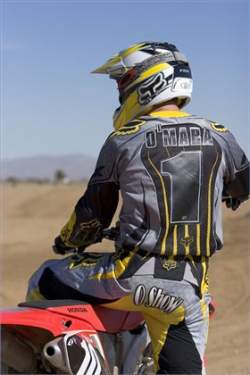
Age 39, 6’0”, 170 lbs.
RL raced motocross from a very young age, but he quit racing so that his brother, Phil, could continue on as a professional. Randy became his mechanic and then spun wrenches for Doug Dubach, Ping, Jeremy McGrath, and Ezra Lusk during his career. He also raced downhill mountain bikes for several years, and the experience he gained during that time led him to his current job as a trainer-coach. He currently works with Ryan Villopoto and Nick Wey.
Chad Pederson
Age 35, 5’7”, 170 lbs.
Chad Pederson was one of the brightest up-and-coming stars on a minibike in the late 1980s. He transitioned smoothly into the professional ranks, winning the Tampa Supercross 125cc class in 1994 and running at the front in the national motocross series. After some injury problems, Chad went on to finish second several times in the AMA Arenacross Series and now runs motocross schools in the Minneapolis area.
Phil Lawrence
Age 35, 6’2”, 190 lbs.
“Factory” Phil Lawrence came very close to winning the 1993 125 Supercross Championship for Team Suzuki. If it weren’t for a broken clutch lever at one of the rounds, he would probably have a #1 plate hanging on his wall. Phil won the Seattle Supercross that season and finished on the podium in the 250 class at Glen Helen later that same year. The following season, he finished fourth in the 250 supercross series, one of the highest overall finishes for a privateer. He runs his own business today and still rides on a regular basis.
Victor Sheldon
Age 40, 5’9”, 160 lbs.
Victor Sheldon is an eight-time Jet Ski national and world champion. He is also a great motocross rider and has a Mammoth Mountain Motocross title in the Vet Intermediate class. He is also a rider manager for Thor MX, taking care of riders like Jeremy McGrath, Chad Reed, and Ryan Villopoto.
David Pingree
Age 31, 5’7”, 160 lbs.
David Pingree has been riding dirt bikes since he five years old. He has four supercross wins and an empty spot on his wall where a #1 plate should have been.
